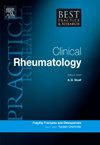Assessment of disease activity and damage in SLE: Are we there yet?
IF 4.5
2区 医学
Q1 RHEUMATOLOGY
Best Practice & Research in Clinical Rheumatology
Pub Date : 2023-12-01
DOI:10.1016/j.berh.2023.101896
引用次数: 0
Abstract
Systemic Lupus Erythematosus is a systemic autoimmune disease characterized by a great heterogenicity in course and clinical manifestations. Although prognosis improved in the last decades of the 20th century, mortality remains higher than in the general population and uncontrolled disease activity and therapy-related adverse effects have been identified as major contributors to damage accrual and poor outcomes. Assessment of disease activity and damage in SLE represents a great challenge even to the expert rheumatologist. Global disease activity indices are tools developed to assess activity across multiple organ systems. Several disease activity indices have been developed over the years, each with its own strengths and weaknesses, and knowing them is essential for understanding research studies, such as clinical trials, in which they are used. Organ-specific activity indices have been developed concurrently to represent organ involvement such as glomerulonephritis, cutaneous and musculoskeletal lupus manifestations. Regarding damage, the SLICC/ACR damage index has proven to be an effective tool for damage accrual assessment, yet not devoid of drawbacks. This review provides an overview of the most frequently utilized indices developed for the assessment of activity and damage in SLE highlighting their pros and cons when applied to the research and clinical setting.
SLE患者疾病活动性和损害的评估:我们做到了吗?
系统性红斑狼疮是一种全身性自身免疫性疾病,其病程和临床表现具有很大的异质性。虽然预后在20世纪最后几十年有所改善,但死亡率仍然高于一般人群,并且不受控制的疾病活动和治疗相关的不良反应已被确定为损害累积和预后不良的主要原因。即使对风湿病专家来说,评估SLE的疾病活动性和损害也是一个巨大的挑战。全球疾病活动性指数是评估跨多个器官系统活动性的工具。多年来已经开发了几种疾病活动指数,每种指数都有自己的优点和缺点,了解它们对于理解使用它们的研究(如临床试验)至关重要。器官特异性活动指数已同时发展,以代表器官受累,如肾小球肾炎,皮肤和肌肉骨骼狼疮的表现。在损伤方面,SLICC/ACR损伤指数已被证明是一种有效的损伤应计评估工具,但并非没有缺陷。本综述概述了用于评估SLE活动性和损害的最常用指标,并强调了它们在应用于研究和临床环境时的优缺点。
本文章由计算机程序翻译,如有差异,请以英文原文为准。
求助全文
约1分钟内获得全文
求助全文
来源期刊
CiteScore
9.40
自引率
0.00%
发文量
43
审稿时长
27 days
期刊介绍:
Evidence-based updates of best clinical practice across the spectrum of musculoskeletal conditions.
Best Practice & Research: Clinical Rheumatology keeps the clinician or trainee informed of the latest developments and current recommended practice in the rapidly advancing fields of musculoskeletal conditions and science.
The series provides a continuous update of current clinical practice. It is a topical serial publication that covers the spectrum of musculoskeletal conditions in a 4-year cycle. Each topic-based issue contains around 200 pages of practical, evidence-based review articles, which integrate the results from the latest original research with current clinical practice and thinking to provide a continuous update.
Each issue follows a problem-orientated approach that focuses on the key questions to be addressed, clearly defining what is known and not known. The review articles seek to address the clinical issues of diagnosis, treatment and patient management. Management is described in practical terms so that it can be applied to the individual patient. The serial is aimed at the physician in both practice and training.

 求助内容:
求助内容: 应助结果提醒方式:
应助结果提醒方式:


